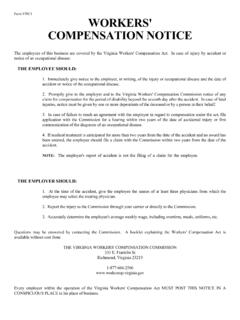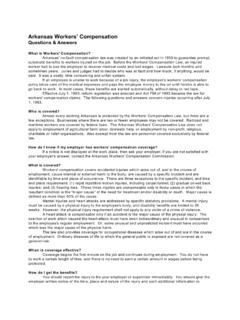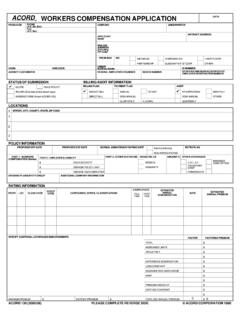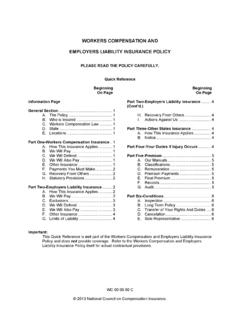Transcription of Railroad Retirement and Survivor Benefits - RRB.Gov
1 Railroad Retirement BoardRAILROAD Retirement and Survivor BENEFITSThe Railroad Retirement Board s mission is to administer Retirement / Survivor and unemployment/sickness insurance benefit programs for Railroad workers and their families under the Railroad Retirement Act and the Railroad Unemployment Insurance Act. These programs provide income protection during old age and in the event of disability, death or temporary unemployment and sickness. The Railroad Retirement Board also administers aspects of the Medicare program and has administrative responsibilities under the Social Security Act and the Internal Revenue Code. In carrying out its mission, the Railroad Retirement Board will pay Benefits to the right people, in the right amounts, in a timely manner, and will take appropriate action to safeguard our customers trust funds.
2 The Railroad Retirement Board will treat every person who comes into con tact with the agency with courtesy and concern, and respond to all inquiries promptly, accurately and clearly. Railroad Retirement BoardMISSION STATEMENTThe Railroad Retirement Act is a Federal law that pro-vides Retirement and disability Benefits for qualified Railroad employees, spouse annuities for their wives/husbands, and Survivor Benefits for family members of deceased employees who were insured under the Act. The Railroad Retirement Board (RRB) administers these benefit programs, as well as the Railroad Unemployment Insurance Act, and has administrative responsibilities un-der the Social Security Act for certain benefit payments and Railroad workers Medicare booklet describes the Retirement and disability an-nuities provided for Railroad employees under the Railroad Retirement Act, and the Benefits available to their spouses and survivors.
3 The information in this publication super-sedes earlier editions. Medicare and unemployment/sick-ness insurance Benefits are described in separate booklets. In addition, RRB publications covering Benefits and other related topics are available at under the Ben-efits tab of the main menu. RRB customers can request the following documents through self-service options available online at and through the automated menu of the agency s toll-free number (1-877-772-5772): replacement Medicare card monthly rate verification letter duplicate tax statement for the most recently completed tax year statement of creditable Railroad service and with myRRB accounts can log in to get an-nuity estimates, apply for or claim unemployment bene-INTRODUCTION fits, claim sickness Benefits , view Railroad Unemployment Insurance Act account statements, and review service and compensation booklet is issued for the purpose of general information.
4 Certain limitations, exceptions, and special cases are not covered. Page EMPLOYEE AND SPOUSE ANNUITIESS ervice and Earnings .. 1- Military Service .. 2- Service and Earnings Records .. 3 Employee Annuities.. 4- Age and Service .. 4- Disability .. 5- Supplemental Annuities .. 6 Current Connection Requirement .. 7 Spouse Annuities .. 9 Employee and Spouse Annuity Estimates ..11 Two-Tier Annuities and Dual Benefits ..12- Employees with Railroad Retirement and Social Security..13- Employees with Public, Non-Profit, or Foreign Pensions ..14- Workers Compensation ..14 Spouses with Dual Benefits ..14- Social Security Benefits ..14- Public Pensions ..15- Employee Annuity..15 Minimum Guaranty ..15 Cost-of-Living Increases ..16 Working After Retirement ..17- Disability Work Restrictions.
5 19 When Annuities Stop .. 20 Survivor BENEFITST ypes of Survivor Benefits ..21 Survivor Annuity Estimates ..24 Survivor Annuity Tiers..25 Survivors with Dual Benefits ..25- Social Security Benefits ..25 - Public Pensions .. 26 - Employee Annuity.. 26 Cost-of-Living Increases ( Survivor )..27 Work and Earnings Limitations..27 When Survivor Payments Stop .. 28 Lump-Sum Death Benefits .. 29 CONTENTSPage Retirement AND Survivor INFORMATIONA pplying for an Annuity ..31If Requirements are not Met ..35 Garnishments/Property Settlements ..35 Monitoring Benefit Payments..36 The Right to Appeal..36 Railroad Retirement Taxes..38 Dual Tax Payments ..38- Dual Railroad Retirement -Social Security Taxes .. 40- Separation/Severance Allowances.. 40 Federal Income Tax..41 ANNUITY FORMULA COMPONENTSE mployee Retirement Annuity.
6 42- Tier I..42- Tier II ..46- Supplemental Annuity Formula..46 Spouse Annuity ..47- Tier I..47- Tier II ..49 Dual Annuities..50 Survivor Annuity ..50- Tier I..50- Tier II ..53 RRB FIELD OFFICES ..551 SERVICE AND EARNINGSR ailroad Retirement Benefits are based on months of ser-vice and earnings credits. Earnings are creditable up to cer-tain annual maximums on the amount of compensation sub-ject to Railroad Retirement taxes. An employee will receive credit for a month of Railroad service for every month in which he or she had some com-pensated service for a covered employer (under the Railroad Retirement Act), even if the employee only performs one day of service in a given month. (However, any local lodge com- pensation earned after 1974 is disregarded if it is less than $25 for any calendar month.)
7 Covered employers include interstate railroads and their affiliates engaged in Railroad -connected operations, as well as employer associations and national railway labor organizations and their subordinate units. Service performed for a covered employer or as an em-ployee representative is creditable toward all types of bene-fits under the Railroad Retirement Act. Service months need not be consecutive, and, in some cases, military service may be counted as Railroad service. Special rules may apply when crediting service months resulting from a settlement for an on-the-job service months may be deemed in some cases where an employee does not actually work in every month of the year. For additional service months to be deemed, the employee s compensation for the year, up to the tier II maximum, must exceed an amount equal to 1/12 of the tier II maximum multiplied by the number of service months actually worked.
8 The excess amount is then divided by 1/12 of the tier II maximum; the result, rounded up to a whole number, equals the maximum number of months that may be deemed as service months for that year. The employee EMPLOYEE AND SPOUSE ANNUITIESRAILROAD Retirement AND Survivor BENEFITS2must be in an employment relation (on an approved leave of absence) with a covered Railroad employer, or be an em-ployee representative, during a deemed service month. An employee may never be credited with more than 12 service months in any calendar year. Except for Benefits paid for on-the-job injuries, sickness Benefits are subject to tier I Railroad Retirement taxes if paid within 6 months after the month in which the employee last worked. They are credited as compensation for tier I Benefits but are not credited as service months.
9 Military ServiceActive duty military service may be credited towards re-tirement Benefits under certain conditions. To be creditable as compensation under the Railroad Retirement Act, an em-ployee's service in the Armed Forces must be preceded by Railroad service in the same or preceding calendar year. With the exceptions noted, the employee must also have en-tered active military service when the United States was at war or in a state of national emergency, or have served in the Armed Forces involuntarily. If an employee's military service began during a war or national emergency period, any active duty service he or she was required to continue in beyond the end of the war or na-tional emergency is creditable, except any voluntary service extending beyond September 14, 1978, is not workers who voluntarily served in the Armed Forces between June 15, 1948, and December 15, 1950, when How much creditable Railroad service is needed for a regular employee annuity?
10 10 years (120 months)OR5 years (60 months) if performed after 1995 Employee and Spouse Annuities3there was no declared national state of emergency, can be given Railroad Retirement credit for their military service if they performed Railroad service in the year they entered or the year before they entered military service, and if they re-turned to rail service in the year their military service ended or in the following year and had no intervening nonrailroad employment. Veterans should contact the RRB well in advance of re-tirement regarding required proof of military service. Service and Earnings RecordsEmployers are required to report their employees' service and earnings compensation to the RRB, which maintains a record of all covered Railroad service and creditable earn-ings after 1936.








